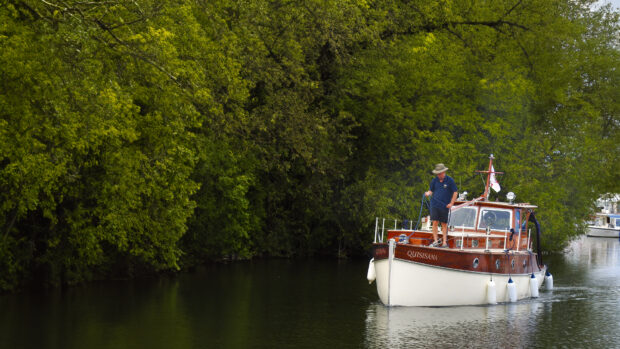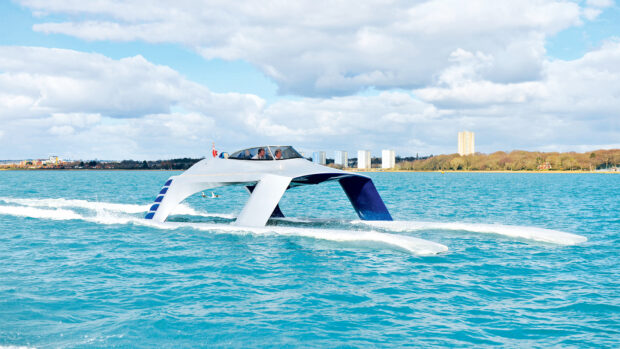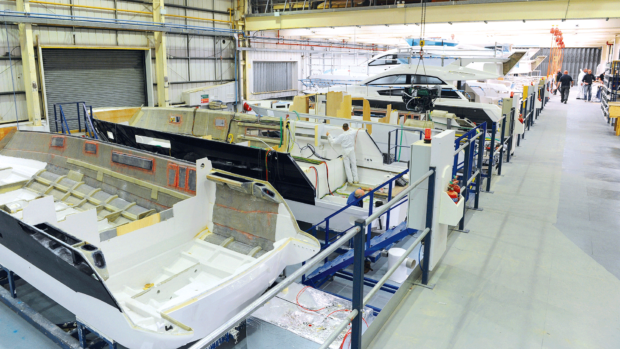It’s not just a ferry port – Calais opens the door to some of the most picturesque waterways and inlets in Northern Europe
The low North Sea coast between Calais and the Netherlands is classic cruising country for boats based around the Thames or the tip of Kent. Solent crews come here too, and anyone bound for Holland heads for Calais first before hopping east towards the wide West Schelde estuary. Even West Country boats venture up now and then to cross the Channel and make the time-honoured foreign landfall near Cap Blanc-Nez.
I’m fond of this corner of le Continent, so close to our own white cliffs yet so different in its way of life. A ferry port for centuries, Calais has kept its Gallic character despite the continuous invasion from across the water. The bakers open early and locals still carry baguettes under their arms. You can sip strong coffee at a pavement café while watching the town coming to life.
Beyond Calais, you leave the relatively simple waters of the Channel to enter a more intricate world of sandbanks, skimpy depths and processions of offshore buoys leaning to frothy tides. On windy days, short steep seas break over the banks, yet the ports of call are nicely spaced and all very welcoming. Gravelines is a gem, with a long river entrance and historic fortress town. Dunkirk is rather special, and it’s a surprise to find such stylish city marinas behind the industrial approaches.

Nieuwpoort has three large marinas in rural surroundings and Ostend’s easy vibes and seafood stalls make visitors feel instantly at home. At Zeebrugge, you pass looming container ships to enter an almost villagey yacht harbour. Not far to the east, a shipping channel leads into the majestic Westerschelde River, whose deep fairways wind up to the elegant city of Antwerp.
Behind these colourful harbours, a little-known canal network offers rewarding diversions – to the splendid medieval city of Bruges, for example – a short run south from Zeebrugge. So while this coastline gives nothing away as you peer inshore through the glasses, there’s much going on beyond the deadpan façade of beaches, marram grass dunes and stark jutting piers. This is a region worth getting to know.
Crossing the Channel
From Dover to Calais is only 22 miles, yet this short passage has a dramatic quality even in quiet weather. There’s a strange tension when two countries face each other across a narrow strait, and remember that heavy guns were fired across here within living memory.
This is also the world’s busiest waterway and the constant stream of shipping and ferry traffic adds to the sense of theatre. The tides can squeeze through this gap at over 3 knots, kicking up a boisterous chop against brisk winds. Yet I have often crossed in almost glassy conditions, with France hidden in summer haze most of the way, until the green slopes behind Cap Blanc-Nez and the long beach past Sangatte take shape ahead.
The approach channel converges with the beach as you follow the green buoys towards the entrance. Cross-Channel ferries rumble in and out at a fair lick, shaving past holidaymakers splashing about off the golden sands. Beach huts cheer the scene and rows of red-roofed houses catch the sun.
Article continues below…

Dutch cruising guide: Exploring the nether-Netherlands

Secret South Coast cruising: Discovering the hidden gems of Sussex and Kent
Obey the pierhead traffic signals and if it’s clear to enter, dive in quickly, keeping to the west side away from the ferry berths. There are visitors’ buoys at the head of the inner harbour, where you can wait for the Bassin de l’Ouest marina gate, open for 2.5 hours each side of high water.
Lazing in Calais
While the port of Calais is hectic, the marina is remarkably restful. The berth holders are laid-back and whenever we call here, I seem to laze on board between drinks and meals, yarning with passing crews and generally doing very little.
Ashore, most visitors converge on the bars and bistros around Place d’Armes, but Calais has a more interesting watery side because its central part is surrounded by canals and harbour basins. From the roundabout south of the marina, stroll down Esplanade Jacques Vendroux past a sturdy 16th-century citadel to the canal quays once used by trading barges. Along here is the lock junction where the Canal de Calais heads off to join the main French waterways that carry you to Paris and beyond.

One of the many bountiful seafood stalls in Calais
Continuing anticlockwise around the quays, you arrive at the fishermen’s quarter around Bassin du Paradis, with the distinctive artisans houses you saw when arriving in the harbour. Nearby, the soaring Calais lighthouse is open to visitors and the spectacular view from the top is worth the giddy climb. Calais is a minefield of tourist bistros so you need to escape from the centre. We like La Buissonnière, about half an hour’s walk due south of the marina gate.
Round to Gravelines
Cruising on from Calais, don’t miss calling at Gravelines, only ten miles to the east but often passed by on that account. Aim to leave Calais as soon as the marina gate opens and head due north from CA6 red buoy for 1.5 miles before turning ENE for four miles to clear the Calais coastal shoals.

The pretty harbour at Gravelines is well worth the short diversion from Calais
Then track east to the Gravelines piers, built nearly a mile out from the beach. Inside, you’ll carry the last of the flood up a straight river channel past a disused lighthouse with black-and-white helter-skelter stripes.
The River Aa continues inland for another mile to a snug yacht harbour and old walled town. The marina gate opens three hours each side of HW in season and the visitors’ berths are just inside to starboard. Gravelines is a friendly, low-key place and the west side of the marina is open country. We are always pleased to have made the effort to come in here and usually end up staying several days.
Gravelines old town
Downstream from the marina on the east shore, the walled town is a perfect example of a star-shaped fortress, rebuilt by the ubiquitous engineer Vauban in the early 18th century. Entering the gate along Boulevard Salomé, you cross a moat canal to Place Valentin, with its elegant Hôtel de Ville and Friday-morning market.

Make time to stroll around the historic fortress at Gravelines
The military outworks are fun to explore and the original fortress is almost entirely intact, its bastions reinforced by demi-lunes and counterguards. In the outer fortifications you’ll find a bird sanctuary, and inside the bastions are landscaped gardens. The marina brasserie is okay, but on a summer’s evening I would stroll to La Petite Métisse, about 3km east of the marina on the D11.
Dunkirk
Less than three miles east of Gravelines, Dunkirk’s Port Ouest is strictly for ships, but seven miles further along the sprawling dock frontage, a rather fine brick lighthouse marks the entrance to Port Est, from where a channel hugs the far breakwater towards two sheltered marinas − Port du Grand Large on the east bank and Yacht Club de la Mer du Nord on the west.
The long visitors’ pontoon at Grand Large is easy for bigger motor boats and accessible at any tide. However, my favourite billet is the restful marina in Bassin de la Marine, reached through a lock and a couple of lifting bridges but well worth this procedure for its prime location near the inner harbour waterfronts. Dunkirk centre is a treat after the dour industrial approaches.

The lifting bridge leading to Dunkirk’s inner marina
Virtually flattened during World War II, the town was rebuilt in a more inspired idiom than Calais, and the elegant buildings around Bassin du Commerce lift the spirits and give the place character. Centrepiece of the inner harbour is the three-masted sailing ship La Duchesse Anne, whose lofty spars and crossed yards tower above the restored warehouse buildings along Quai de la Citadelle.
Operation Dynamo
Dunkirk will always be associated with the World War II operation to evacuate British and French troops from its port and beaches in the early summer of 1940. German tank divisions had broken through the French front and moved quickly towards the Channel coast, taking Boulogne and Calais by May 26.
The Allied forces retreated to Dunkirk and 340,000 soldiers were ferried back to England by about 1,400 British and French vessels of all kinds, including many private motorboats and yachts. This incredible story is eloquently told in the Dunkirk 1940 Museum, a short stroll from Port du Grand Large on Rue des Chantiers de France. Every few years, a flotilla of Dunkirk ‘Little Ships’, some now quite elderly, gathers in the harbour here for a reunion.
Near the SE corner of the inner basins, l’Estaminet Flamand on Rue des Fusiliers Marins is a cosy brasserie with consistently fine cooking.

Colourful historic vessels still ply these busy waters
Calling at Nieuwpoort
East of Dunkirk, the inshore channel dodges seawards a couple of miles to clear the Broers Bank and then the buoyed Westdiep leads towards Nieuwpoort and Ostend. Nieuwpoort is a seaside resort at the mouth of the Yser River, with a huge marina complex inside. Two entrance piers stick out from the beach and then you pass marshy shores before reaching yacht berths each side of the river.
The west bank marina run by the Royal Yacht Club Nieuwpoort is an attractive sheltered pool with a comfy clubhouse and restaurant. The largest marina is on the east bank in the nouveau port. Here you’ll find comprehensive lift-out and repair facilities, a good fuel berth, chandlers and everything else you’d expect. Nieuwpoort is an excellent place to leave a boat for a while and is also a good entry point for the Belgian canals.
Along to Ostend
While Nieuwpoort is low key from seaward, Ostend looms large as a garish splodge of high-rise buildings long before you spot the entrance. However, things feel better as you approach the two long jetties and catch the good-natured vibes of this lively harbour. Holidaymakers paddle on the beaches or stroll along the prom.

The Mercator training ship in the heart of Ostend harbour
As you pass the control tower, idlers wave from the west jetty as they sample the moules-frites stalls. Ostend’s easy friendliness is infectious and I have always enjoyed being here.
The two most practical berths for visiting motorboats are either Mercator Yacht Harbour, entered through a lock at the south end of Montgomery Dock, or the Royal Yacht Club of Ostend pontoons at the head of the Voorhaven. The Mercator is the most convenient for the town restaurants and bars. The Royal Ostend is more secluded, with a calm traditional atmosphere.
Ashore in Ostend
If you are moored in the Mercator Basin, don’t miss the maritime museum on board the 1932 Scottish-built barquentine, which is such a dramatic centrepiece to the harbour. Wandering north along Boulevard Leopold II, you pass the peaceful lake and gardens of Leopold Park, a popular retreat for Ostenders in their lunch hours.
A little further up, the grandiose Casino is right on the seafront, where you can linger at one of the terrace cafés and watch the world and sea go by. Out on the horizon is a seemingly endless procession of ships. Wandering east along the prom towards the Royal North Sea Yacht Club, you can follow the town quays back to Mercator Marina. We recently ate well, and refreshingly simply, in a small family-run fish restaurant called Adelientje on Bonenstraat – near the fish market, back in from the quay.

Dunes like these outside Blankenberge make an evocative backdrop to this cruising area
Blankenberge
From Ostend, you can skirt the coast quite close inshore, keeping outside a line of north-cardinal buoys. Three miles before Zeebrugge’s massive jetties, a pair of modest piers leads to the yacht basins at Blankenberge. Not many boats visit this slightly grotty resort, though the marina locals are extremely jolly.
The best reason for coming here is to eat seafood at the Restaurant Oesterput, a cavernous, convivial canteen on the west side of the harbour entrance. The lobsters are superb, and so is everything else.
Zeebrugge
The enormous walls of this commercial port stretch nearly two miles out from the beach. The cranes and container gantries are visible from far off and it looks like a place for motor yachts to scuttle past. Yet Zeebrugge is great to visit if you enjoy seeing ships and barges up close.
Obeying the pierhead signals, it’s easy to slip in past the vibrant docks, keeping broadly right towards the yacht harbour. The visitor berths are just inside the marina to port, where the Royal Belgian Sailing Club members are always helpful. My favourite eatery is Martin’s Visrestaurant, set back from the harbour opposite a church. Very ordinary outside, superlative within.

Zeebrugge’s container port hides a charming village harbour behind it
Into the Westerschelde
From Zeebrugge, you can merge into the south side of the busy Scheur channel, which carries ships of all nations in and out of the Westerschelde. The upper reaches of this strategic river have important oil terminals, bulk carrier quays and container ports.
The lower Schelde shores are flat and featureless in that ghostly style of Dutch estuaries, but the buoys soon lead you round to Breskens, a bustling yachting and fishing harbour on the south bank, handy for a night before catching a fair tide for the 50-mile run up to Antwerp. Breskens-Aan-Zee is a delightful beach café west of the harbour, with amazing views of all the shipping.
Cruising up to Antwerp
The Schelde tides are powerful, and even fast boats should carry the flood upstream to Antwerp, leaving Breskens soon after low water. Sandbanks divide the lower river into an intriguing choice of channels and you can take your pick for the first 20 miles using Admiralty chart 120.

Traditional barges grace the quays in Antwerp city harbour
At Terneuzen, the Ghent ship canal joins the Schelde through immense locks and just upstream is a pleasant marina, easy to enter between two enclosing jetties. Above Terneuzen, the river makes a U-bend round Ossenisse island, a wild part of the Schelde with few signs of habitation. A tight bend opposite Bath is a tricky turn for large ships, so stay out of their way. From here, the river meanders south-east towards Antwerp.
Antwerp marinas
At the last right-angle bend before the city, you can turn off to port along a short canal leading to a lock, two lifting bridges and Willemdok Marina near Antwerp’s old quarter. Alternatively, enter the secluded Linkeroever Marina on the west bank through a single gate (HW ±1hr).
The Royal Yacht Club of Belgium has its clubhouse here, with a restaurant overlooking the river. You can visit the city by catching a bus near the marina or by using the pedestrian tunnel a little way upstream.
Antwerp city
Antwerp centre is surprisingly compact, an enticing warren of linked ‘villages’ each with its own character. Many of the narrow cobbled streets are pedestrian only and trams can whisk you about quickly and cheaply. The main market square – Grote Markt – is a Flemish masterpiece, graced by a flamboyant town hall and the towering Gothic cathedral whose spire is prominent as you arrive up the river.

Be sure to sample
the oysters at one of Antwerp’s many stalls
On warm summer evenings, the cathedral’s great tenor bell tolls across the brasserie terraces where most of the city’s population seem to relax over drinks. Be sure to visit the Museum aan de Stroom, an eye-catching red sandstone creation on the west side of Willemdok.
Their imaginative exhibitions cover all aspects of Antwerp’s history and heritage. From Willemdok, it’s not far to my favourite eatery Het Pomphuis (the pump house) next to a fascinating waterway junction. Just head north from the marina along the east quay road.
Charts and guides
You must have up-to-date charts for this heavily buoyed area. From west to east use Admiralty 1892, 323, 1873, 1874, 120. There is no single pilot book in print for this coast. North France & Belgium Cruising Companion by the late Neville Featherstone would be useful. Otherwise, Reeds Nautical Almanac 2019 is excellent.










